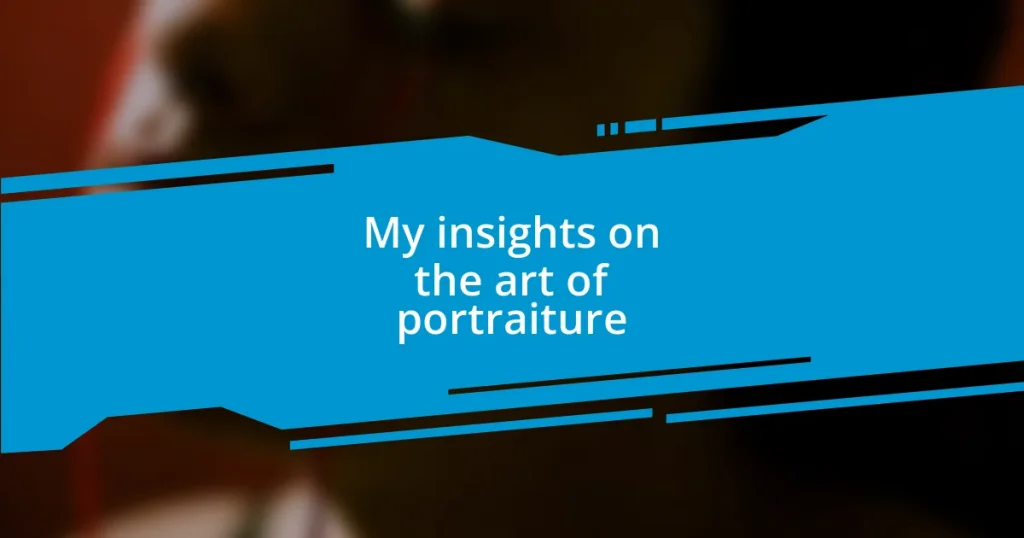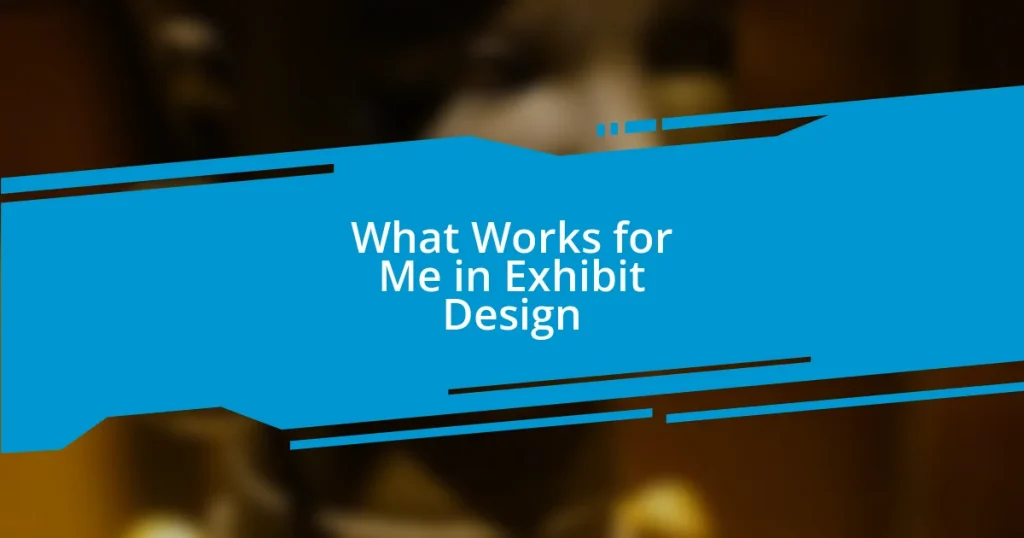Key takeaways:
- Portraiture goes beyond mere representation; it requires capturing the subject’s essence through emotional connection, lighting, and composition.
- Effective tools such as camera lenses and lighting equipment enhance portrait quality, while thoughtful background setup contributes to the narrative.
- Post-processing should prioritize subtlety and authenticity, using techniques like color grading and selective sharpening to enhance story and emotion without losing character.
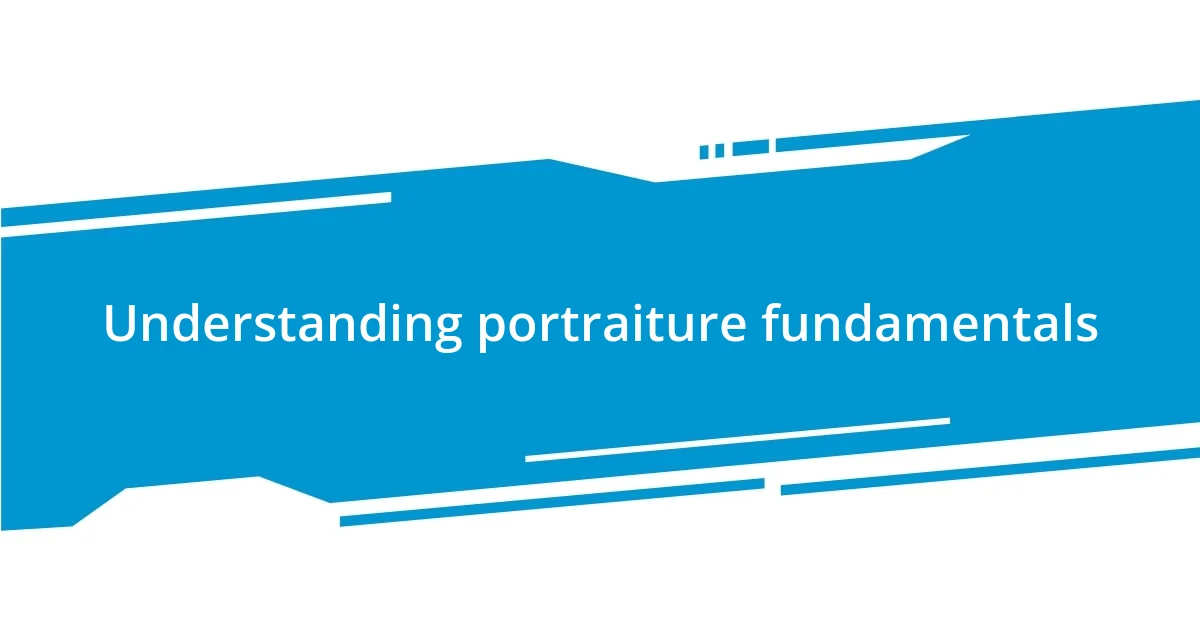
Understanding portraiture fundamentals
Portraiture is not just about capturing a face; it’s about conveying the essence of a person. I remember my first attempt at portraiture, where I was so focused on getting the features right that I overlooked the subject’s personality. What I learned from that experience is that the eyes can tell a story far beyond the skin; they hold emotion and character that can transform a photograph from mere representation into something profoundly engaging.
One fundamental aspect of portraiture is lighting. I once experimented with natural light during the golden hour, and the warmth it cast on my subject’s face created an enchanting atmosphere. How can different lighting impacts the mood of a portrait? For me, that experience was a revelation—lighting can elevate a simple image to art, making it crucial to understand the interplay of light and shadows to evoke the right feelings.
Composition also plays a pivotal role in portraiture. I often find myself distracted by surrounding elements in the frame, which can detract from the subject. Reflecting on this, I now approach each shot with intent, ensuring that every aspect contributes to the narrative. Are you considering how the backdrop affects your subject? It’s fascinating to see how thoughtful composition can create a more intimate connection with the viewer, drawing them into the subject’s world.
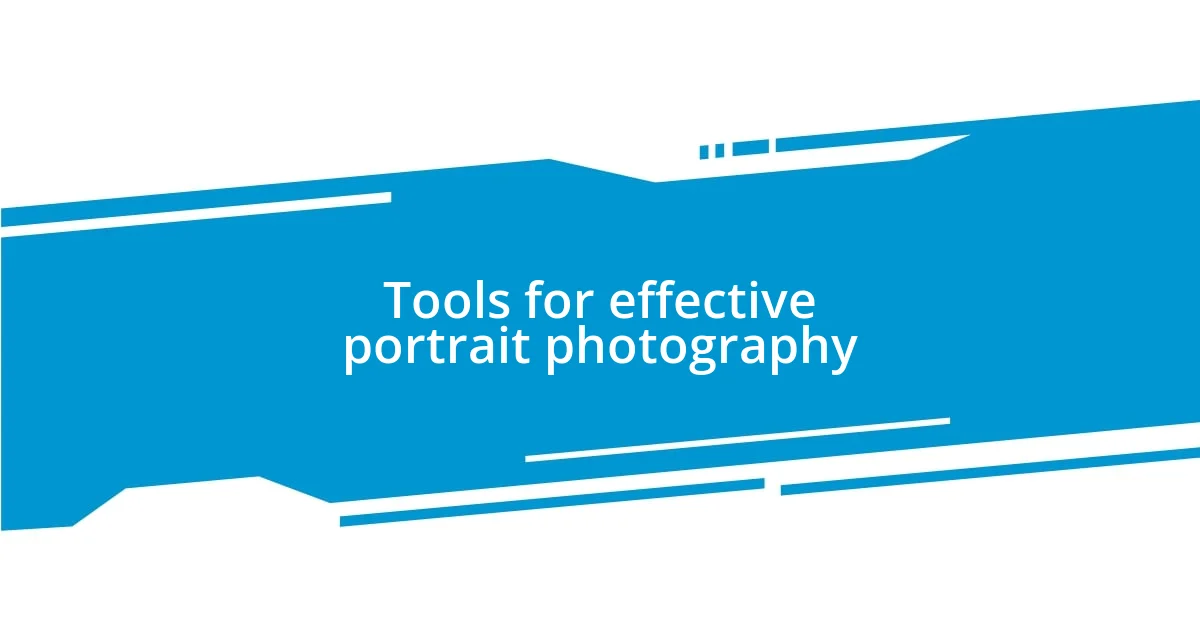
Tools for effective portrait photography
When it comes to the right tools for effective portrait photography, choosing the right camera and lens is crucial. I remember when I switched from a standard kit lens to a prime lens; the clarity and depth of field it brought to my portraits were astounding. It felt like I had transformed from a casual shooter to someone who could really showcase the personality of my subjects. A lens with a wide aperture, like f/1.8 or f/2.8, can create that beautiful bokeh effect that softens the background and helps the subject stand out.
Lighting equipment is equally important, and while natural light can be mesmerizing, having good supplemental lighting can truly enhance a portrait. Once, during a family shoot, I brought along a softbox that diffused the light just right, and the result was a luminous glow on my young subject’s face. There’s no doubt in my mind that this tool allowed me to capture a warmth that would have been lost in harsher lighting.
However, don’t underestimate the value of a well-planned environment. I often visit a location beforehand to visualize how different backgrounds might complement my subject. It’s almost like a rehearsal for a play, where every detail counts. Have you ever felt the vibe of a place before shooting? That anticipation is thrilling and leads to unforgettable portraits that resonate with emotion.
| Tool | Purpose |
|---|---|
| Camera & Lenses | Capture sharp details and depth in portraits |
| Lighting Equipment | Enhance subject illumination and mood |
| Background Setup | Create a harmonious composition |
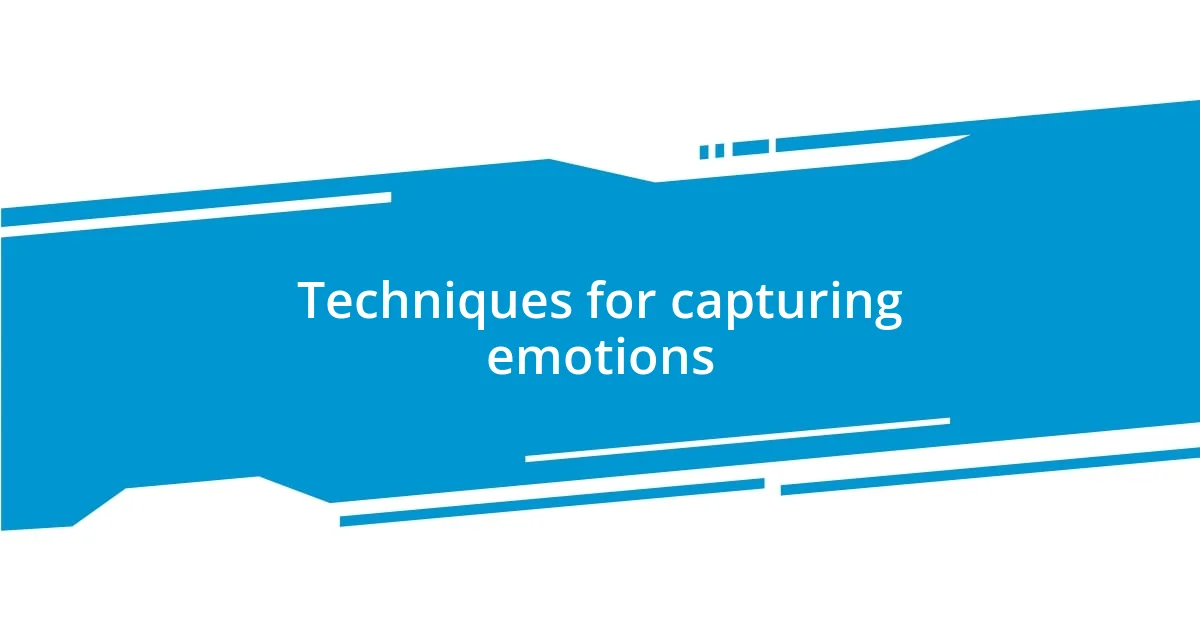
Techniques for capturing emotions
Capturing emotions in portraiture is a skill that requires more than just technical know-how; it calls for a connection with the subject. I once sat down with a shy teenager who was reluctant at first, but as we talked about her favorite books, I noticed a shift in her demeanor. Her laughter and expressions began to unfold, and I realized that drawing out emotions often begins with building rapport. It’s about creating a space where the subject feels safe to be themselves, allowing their genuine feelings to shine through the lens.
Here are some techniques I find effective for capturing those fleeting emotions:
- Establish Trust: Spend time getting to know your subject. This builds comfort, letting real emotions surface.
- Use Candid Moments: Often, the most authentic expressions occur when the subject is unaware of the camera. Look for those spontaneous interactions and smiles.
- Direct with Emotion: I sometimes guide my subjects with prompts that resonate with them, asking questions that evoke memories or feelings. The right direction can pull out unexpected depth.
- Focus on the Eyes: Their eyes often convey the heart of the emotion. I’ve snapped portraits where it felt like I was looking straight into their soul, and those images are the ones that resonate most deeply.
- Adjust Your Lens and Settings for Mood: Play with your camera settings to match the emotional tone. A softer focus, for example, can impart a tenderness that sharp details might overshadow.
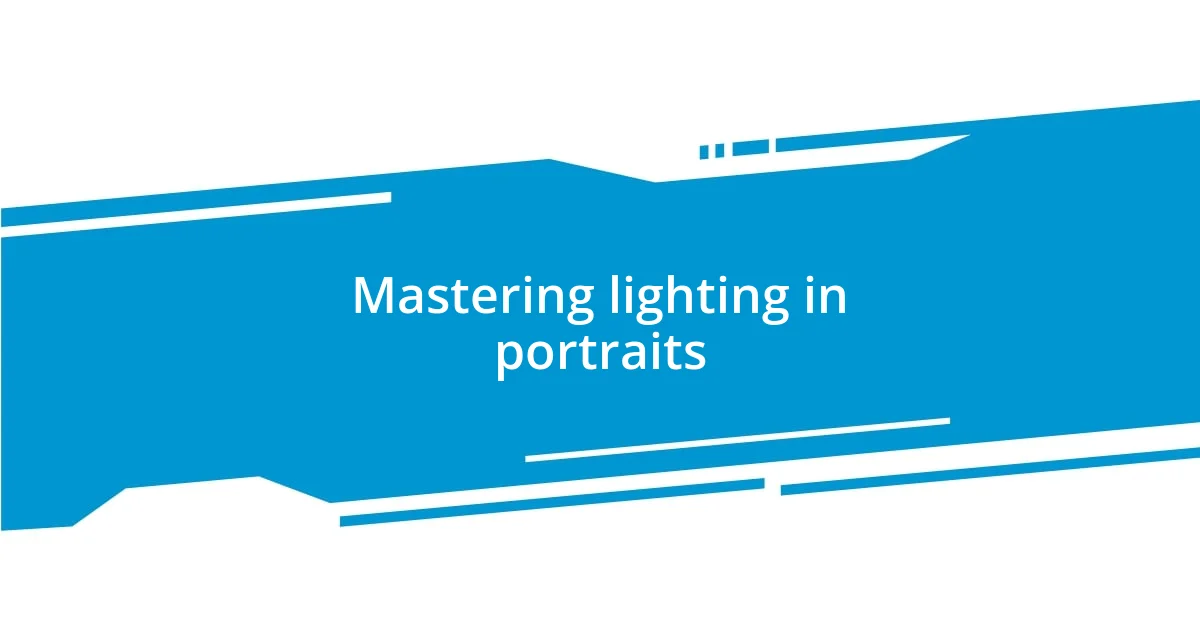
Mastering lighting in portraits
Mastering lighting in portraiture can dramatically alter the mood and impact of an image. I vividly recall a session where I aimed for a dramatic look, using rim lighting to create a striking outline around my subject. The silhouette brought an element of mystery while highlighting their features, demonstrating how different lighting styles can change the entire narrative of a portrait.
When using natural light, consider the time of day and how the sunlight affects your subject. I often find that the golden hour, just before sunset, provides a soft, flattering light that adds warmth to the skin tones. Have you ever witnessed how a simple shift in angle catches that perfect glow? It’s those subtle changes that can elevate a good portrait into a breathtaking one.
For studio lighting, I enjoy experimenting with various modifiers to sculpt the light. Once, during a headshot session, I utilized a beauty dish, which created a gorgeous catchlight in my subject’s eyes. This little detail added depth and life to the image. It’s fascinating to realize that mastering lighting isn’t just about technical skills; it’s about envisioning how light interacts and transforms a moment, capturing not just a face but a story.
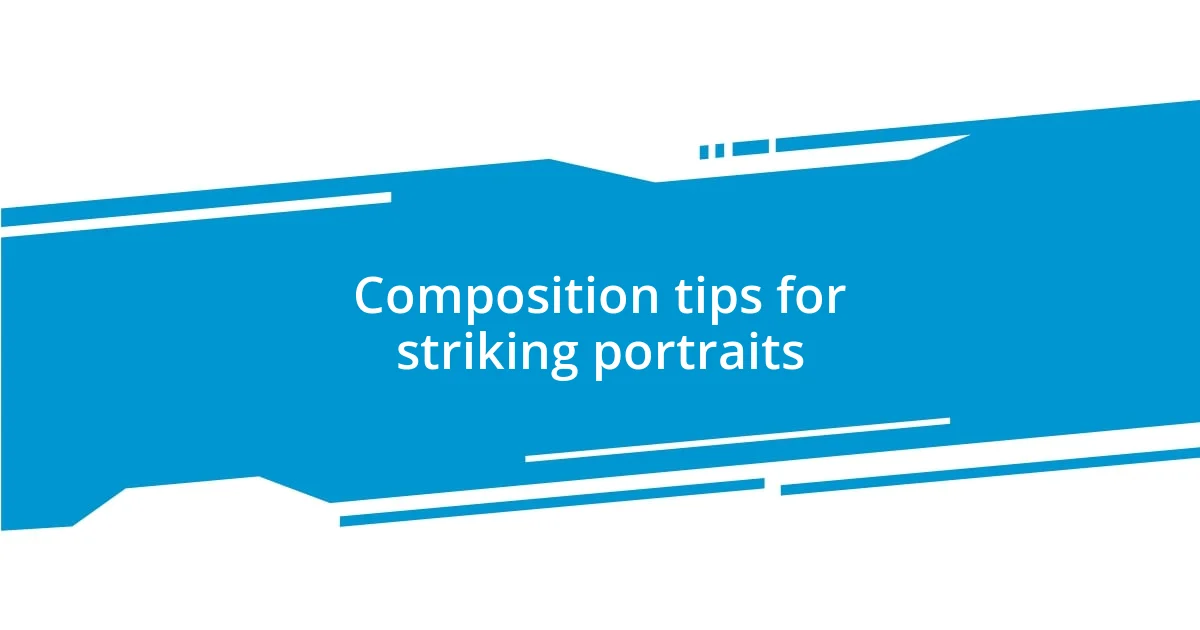
Composition tips for striking portraits
When it comes to composition in portraiture, I often find that the rule of thirds serves as a fantastic starting point. Imagine splitting your frame into nine equal parts; positioning your subject’s eyes along those intersecting lines can create a dynamic balance. I recall a portrait session where I placed my subject slightly off-center, and the resulting image not only felt more engaging but also drew the viewer into the scene, almost as if inviting them into a conversation.
Negative space is another aspect I love to play with. Allowing ample space around your subject can evoke feelings of loneliness or contemplation. There was a time when I photographed a musician in an expansive landscape; the vastness emphasized his connection to the music he loved, turning the portrait into a visual narrative. Have you ever noticed how a little emptiness can amplify the subject’s presence?
Finally, don’t be afraid to incorporate different angles. Sometimes, crouching down or finding a higher vantage point can yield surprising results. I once shot a family portrait from above, and the new perspective gave life to their interactions, transforming a standard pose into a candid moment brimming with happiness. It’s those unexpected angles that can make your portraits truly striking, inviting the viewer to see the world—and your subject—through a fresh lens.
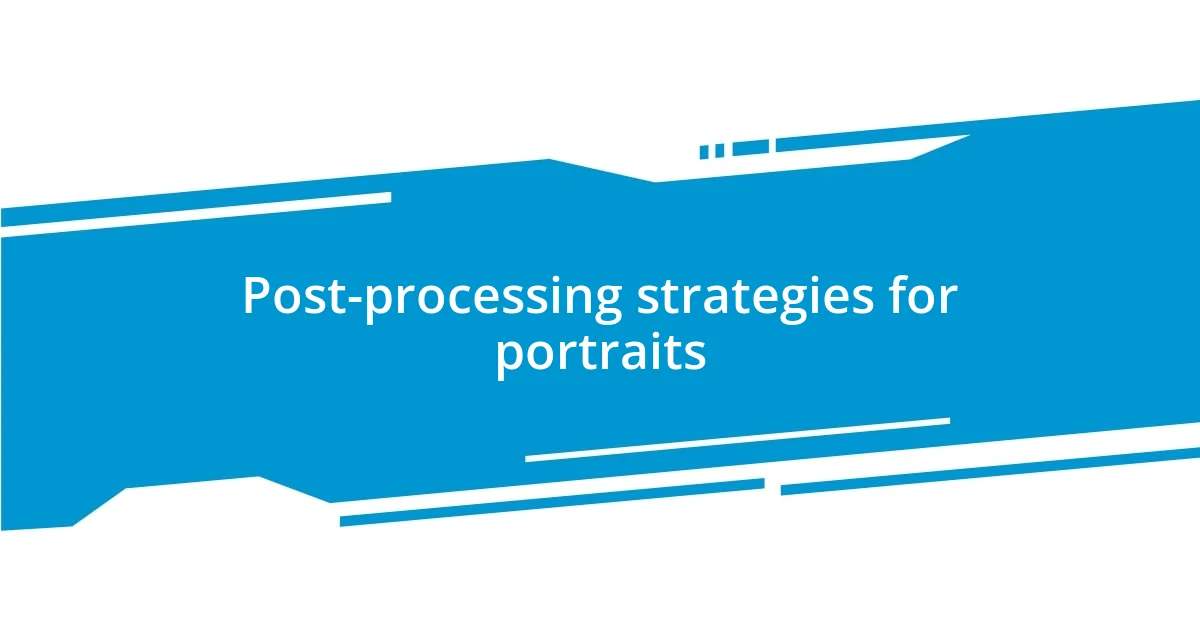
Post-processing strategies for portraits
When it comes to post-processing portraits, I believe that subtlety is key. For instance, I once edited a series of portraits where I focused on enhancing the skin tones without overdoing the smoothing effects. The result was a natural-looking glow that maintained the subject’s textural details—it’s all about balancing enhancement with authenticity. Have you ever felt like too much editing takes away the character of a face? Trust me, keeping the essence of your subject is what truly makes a portrait resonate.
Another strategy I swear by is color grading to set the mood of the portrait. I remember a time when I edited a portrait in warm tones after a cozy autumn shoot. The final image evoked a sense of nostalgia and warmth that was palpable. It’s amazing how a simple shift in color can alter the entire vibe—what emotions are you trying to evoke in your portraits?
Lastly, I often employ selective sharpening to draw attention to my subject’s eyes without diverting focus from the rest of the image. In one particular session, sharpening just around the eyes transformed the portrait, creating an engaging focal point that instantly drew viewers in. Have you considered how a small detail like this can make such a big impact? Thoughtful post-processing can elevate your work, allowing your portraits to convey the story and emotion that words often can’t capture.
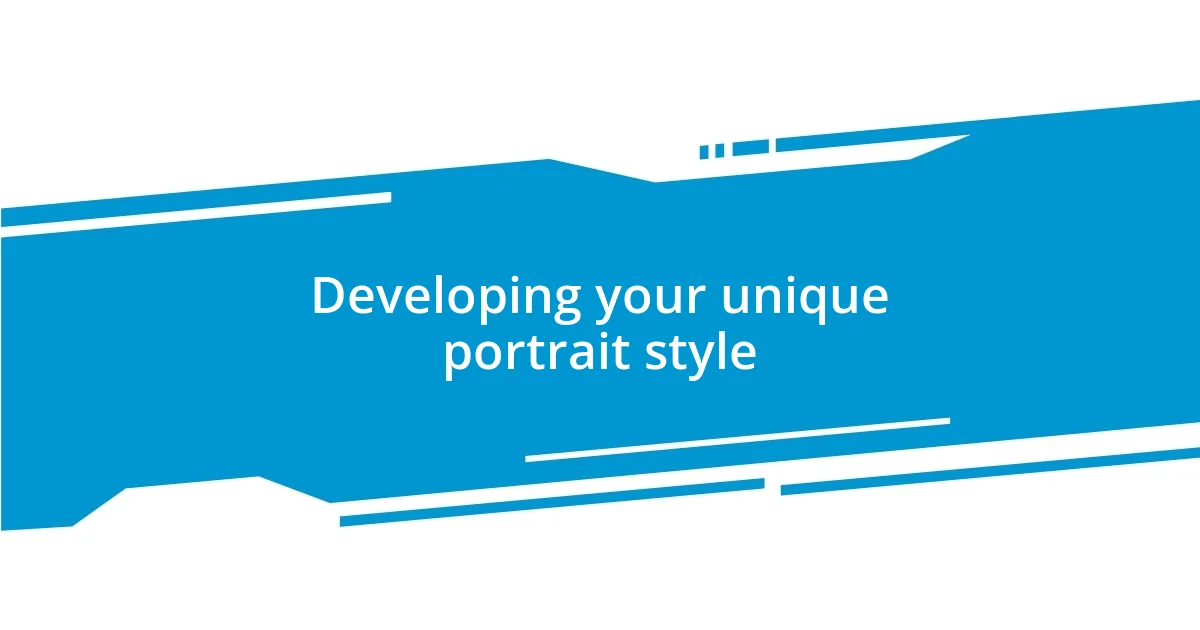
Developing your unique portrait style
When it comes to developing your unique portrait style, I’ve learned that experimentation is crucial. Early in my journey, I decided to explore a series focused on vibrant, bold colors. I remember one shoot where I adorned my subject in a bright red dress against a stark white background. The striking contrast not only highlighted the subject but also infused the image with energy and emotion. Have you thought about how color can transform the mood of your portrait?
Over time, I’ve found that incorporating personal elements into my shoots has helped me carve out my style. For instance, I often include meaningful props that resonate with my subjects. During a portrait session with a painter, we featured her artwork in the background. That addition not only created a sense of authenticity but also sparked a deeper connection between the viewer and the subject. Isn’t it fascinating how personal stories can enhance the narrative of a portrait?
Finally, I’ve realized the significance of lighting in defining my portrait style. Soft, natural light has become my go-to, as it creates a beautiful, ethereal quality that I adore. I recall a golden hour session where the warm sunlight streamed through the trees, casting a magical glow on my subject. That moment reminded me of the power of light—how it can create an atmosphere that resonates emotionally. What kind of lighting speaks to you, and how does it influence the essence of your portraits?











